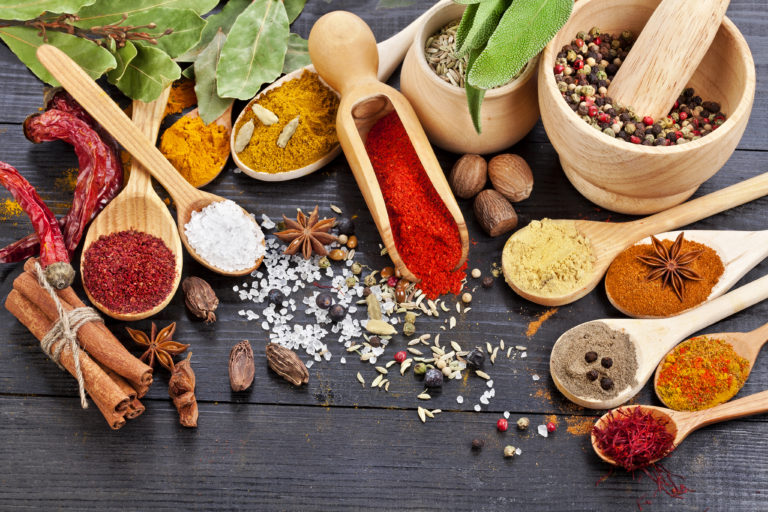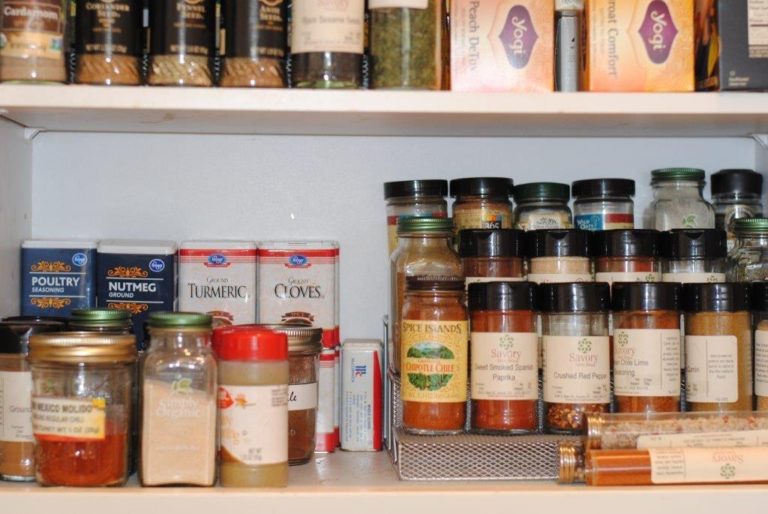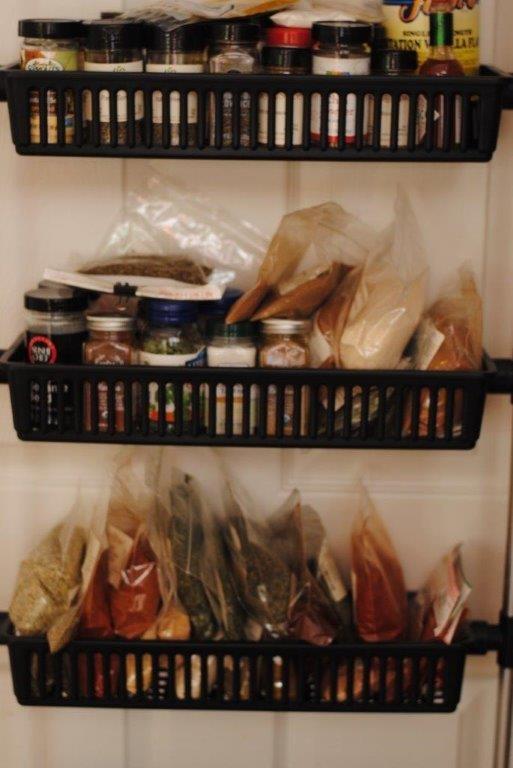 Herbs offer so much, not only in taste and beauty but also health and wellness. Spices can be very confusing and a lot of time overwhelming especially when you visit the spice stores and there are 10 different basil’s to choose from. Do you choose the Mediterranean basil or the California basil or do you choose the regular bay leaves or the California bay leaves? Spices and herbs can help you strengthen your digestion, they are high in antioxidants, they support the nervous system and overall support your immune system. How wonderful to hear that spices and herbs can do all of that for you!
Herbs offer so much, not only in taste and beauty but also health and wellness. Spices can be very confusing and a lot of time overwhelming especially when you visit the spice stores and there are 10 different basil’s to choose from. Do you choose the Mediterranean basil or the California basil or do you choose the regular bay leaves or the California bay leaves? Spices and herbs can help you strengthen your digestion, they are high in antioxidants, they support the nervous system and overall support your immune system. How wonderful to hear that spices and herbs can do all of that for you!
So let’s start first with the main “go to” spices and herbs that I use alot in my cupboard:
- Garlic Powder
- Onion Powder
- Sweet Smoked Spanish Paprika
- Chipotle Chile
- Cumin
- Granulated Garlic
- Cinnamon
- Lemon Pepper
- Ancho Chile
- Dill
- Crushed Red Pepper Flakes
I have many, many more spices and you can see them here in the photo of my spice cupboard:

You can see that I have many more spices than mentioned above, but those are ones that I don’t use as much. Over the past few months I have been working on organizing my spices and moving from the odd size jars to all one size look and feel. It feels really good to open up a cupboard and see all things organized. It is getting there, but still a way to go. I teach Plant Based Cooking Classes so I have purchased a lot of spices and herbs over the past couple of year, but as you can see above I have run out of room to store them. So most recently I purchased a plastic/metal door hanger that fits over my door going down to my basement. This storage unit has allowed me to store all of my “rarely used” spices but also store by refill baggies of spices that I purchased at a spice store. When I open the door and go to the basement the smell of “chilies, cumin and other items” is wonderful! The great thing with this storage hanger is that when I need a refill of my basic spices or need that one special spice it is handy and available and I can always easily check when I need refills.

I will be talking about and sharing information about spices over the next few weeks so let’s start with the “go to” spices and herbs that I mentioned above:
- Garlic Powder
- Benefits: Garlic powder is great for hypertension, different types of fungal and bacterial infections, helping with cholesterol levels, digestion and type 2 diabetes.
- Use: I love garlic but don’t always want to take the time to peel the garlic cloves and mince them (you can purchase minced garlic in water now) so for garlic toasted bread or that little bit of extra garlic taste in marina I grab the jar of garlic powder and always have a lot of this on hand. If you can, use the garlic cloves fresh and you will receive a lot more of the garlic benefits.
- Onion Powder
- Benefits: Onion powder is great for regulating blood sugar, lowers the production of bad cholesterol, gut health, and also helps with the prevention of cancer.
- Use: Onion powder is made from dehydrated onions, giving it a concentrated flavor that pairs well with many foods. Using onion powder when cooking offers health benefits because it contains some nutrients, but in small amounts. I use the onion powder in dishes where I know that I am going to be serving someone a dish that doesn’t like the bits of onion.
- Sweet Smoked Spanish Paprika
- Benefits: Paprika is great for healing wounds, anti- inflammatory, reduces wrinkles and helps protect your eyes.
- Use: Paprika can be used creatively in cooking . Add 2 tablespoons to your favorite pasta sauce. Sprinkle it on potatoes or homemade fries for a change of seasonings – especially when you want a nice smoky flavor. Use it liberally on rice, potatoes, and vegetables when cooking. Use paprika as a milder and smokier seasoning in chili or stews.
- Chipotle Chile
- Benefits: Paprika is great for healing wounds, anti- inflammatory, reduces wrinkles and helps protect your eyes.
- Use: Paprika can be used creatively in cooking . Add 2 tablespoons to your favorite pasta sauce. Sprinkle it on potatoes or homemade fries for a change of seasonings – especially when you want a nice smoky flavor. Use it liberally on rice, potatoes, and vegetables when cooking. Use paprika as a milder and smokier seasoning in chili or stews.
- Cumin
- Benefits: Cumin is great for digestion, constipation, respiratory issues, and anemia.
- Use: Cumin is an herb that many associate with Mexican and Spanish foods, but it is also widely used in Middle Eastern and Indian cooking. It has a very distinct flavor, and in the US is most often used in packaged taco seasonings. If you would like a homemade taco seasoning recipe, please let me know.
- Granulated Garlic
- Benefits: Granulated Garlic is great for hypertension, different types of fungal and bacterial infections, helping with cholesterol levels, digestion and type 2 diabetes.
- Use: The manufacture of both granulated and powdered garlic is the same, except for the grinding or powdering process. Granulated garlic is coarse while garlic powder is ground extra fine. Both granulated and powdered garlic have the same nutritional value. Each variety will produce about the same intensity and flavor when added as seasoning to foods, though the measurements to equal one whole clove will differ slightly: One third of a teaspoon of granulated garlic equals one average-size clove, while it takes approximately half a teaspoon of powdered garlic to equal the same size clove. Powdered garlic dissolves almost instantly when incorporated into any dish, hot or cold. Granulated garlic takes a few minutes to become incorporated and release its flavor.
- Cinnamon
- Benefits: Cinnamon is great for lowering blood sugar levels, reducing heart disease risk factors, and has wonderful anti-inflammatory properties.
- Use: Cinnamon is made by cutting the stems of the cinnamomum tree. The inner bark is then extracted and the woody parts removed from it. When it dries, it forms strips that curl into rolls, called cinnamon sticks. The sticks can be ground to form cinnamon powder. Cinnamon is wonderful in breads, soups for a savory flavor and most anything else.
- Lemon Pepper
- Benefits: Lemon Pepper is great for detoxing, liver and digestion stimulant, and improved immunity.
- Use: Lemon pepper seasoning is quite zesty and flavorful and is used in salads as dressings, and in vegetables, sauces and soups for seasoning. I also use lemon pepper on roasted potatoes. When added onto items it gives excellent aroma and freshness of lemon.
- Ancho Chile
- Benefits: Ancho Chile is great for reducing inflammation, protecting fats in your blood from free radicals, and also contain great antioxidants.
- Use: Ancho chiles is used in many dishes in their fresh, green form as poblanos. As they ripen they turn a dark red almost black and are flat, wrinkled and heart-shaped. At this point you can use the whole dried chile to season dishes like rice or grind it up into the powder form we know as the ancho chile powder.
- Dill
- Benefits: Dill is great for reducing inflammation, also contains great antioxidants and has great antiviral properties.
- Use: Dill is a unique plant in that both its leaves and seeds are used as a seasoning. Dill’s green leaves fern-like and have a soft, sweet taste. Dried dill seeds are light brown in color and oval in shape, featuring one flat side and one convex ridged side. The seeds are similar in taste to caraway, featuring a flavor that is aromatic, sweet and citrus like, but also slightly bitter.
- Crushed Red Pepper Flakes
- Benefits: Crushed Red Pepper Flakes are great to treat digestive problems, circulatory problems, infections and arthritis.
- Use: Crushed Red Pepper Flakes have a lot of spice and flavor without many added calories, fat or sugar. In 1 teaspoon of crushed red pepper, there are only 6 calories and 1 gram of carbohydrate. Most crushed red pepper mixtures contain a variety of different peppers such as bell, jalapeno, ancho and cayenne peppers, which range from mild and peppery to hot and spicy. The pepper seeds are included to increase the spice level.
I hope that you enjoyed this Spicing Up Your Plant Based Lifestyle Post and many more to come.
With Much Cooking Love,

Kelley
Plant Based Kitchenista